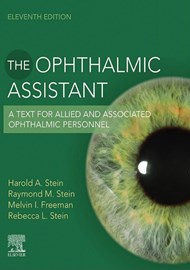The 11th edition of The Ophthalmic Assistant is a great resource for anybody working within the world of eyecare and health. The book really does cater to a wide range of people including theatre staff, ophthalmic nurses, optometrists, dispensing opticians, orthoptists, receptionists, and pharmaceutical companies.
The Ophthalmic Assistant is split into nine sections, each with a variable number of chapters. The book starts with an overview of basic physiology and explains things in a simplistic way, providing adequate definitions of clinical terminology throughout. The second section is on clinical practice, and it really does have something for everyone. It covers topics from history-taking, assessment of visual function, ocular examination, contact lens fitting to dispensing of glasses, office efficiency and how to manage your own practice commercially.
Section three gives an overview of common ocular pathologies seen in clinical practice. This is accompanied by a picture quiz in Section nine of various common eye diseases and disorders. Section four covers basics of surgical techniques and is a valuable overview for any individual working in ophthalmic theatres. Section five covers ocular imaging including OCT, topography, ultrasound, specular microscopy and photography. Importantly CPR is covered in Section six which is essential knowledge for anyone working in healthcare.
I personally really enjoyed Section seven of the book which included chapters on the “history of spectacles” and “art and the eyes”. It was quite fascinating to learn about some of the world’s most famous artists and how their vision potentially influenced their paintings. Finally, the eighth section of the book discusses ethics and touches on the differences in ophthalmology and role of allied ophthalmic professionals across the globe.
At the end of each chapter there are short answer and multiple-choice questions designed to stimulate thinking and test understanding of the material. Answers are provided for the multiple-choice questions but not for the short answer questions. Instead answers for these can be found within the main text of the book or other sources.
Although the size of the book may make some readers feel quite overwhelmed there are numerous coloured pictures and diagrams summarising information throughout the chapters. Readers should also be mindful that some information refers specifically to practice in the USA.
Overall, for anyone currently working in or entering the ophthalmic industry this book will serve a purpose in some shape or form.





